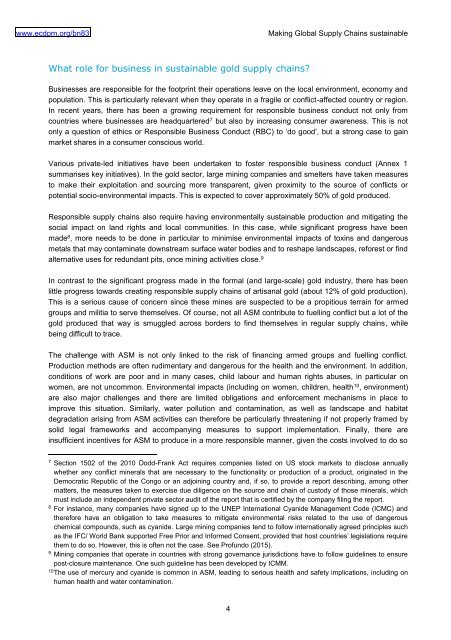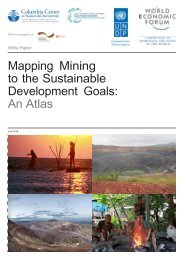Making Global Supply Chains sustainable The case of the gold sector
wuxhtv
wuxhtv
Create successful ePaper yourself
Turn your PDF publications into a flip-book with our unique Google optimized e-Paper software.
www.ecdpm.org/bn83<br />
<strong>Making</strong> <strong>Global</strong> <strong>Supply</strong> <strong>Chains</strong> <strong>sustainable</strong><br />
What role for business in <strong>sustainable</strong> <strong>gold</strong> supply chains?<br />
Businesses are responsible for <strong>the</strong> footprint <strong>the</strong>ir operations leave on <strong>the</strong> local environment, economy and<br />
population. This is particularly relevant when <strong>the</strong>y operate in a fragile or conflict-affected country or region.<br />
In recent years, <strong>the</strong>re has been a growing requirement for responsible business conduct not only from<br />
countries where businesses are headquartered 7 but also by increasing consumer awareness. This is not<br />
a strong <strong>case</strong> to gain<br />
market shares in a consumer conscious world.<br />
Various private-led initiatives have been undertaken to foster responsible business conduct (Annex 1<br />
summarises key initiatives). In <strong>the</strong> <strong>gold</strong> <strong>sector</strong>, large mining companies and smelters have taken measures<br />
to make <strong>the</strong>ir exploitation and sourcing more transparent, given proximity to <strong>the</strong> source <strong>of</strong> conflicts or<br />
potential socio-environmental impacts. This is expected to cover approximately 50% <strong>of</strong> <strong>gold</strong> produced.<br />
Responsible supply chains also require having environmentally <strong>sustainable</strong> production and mitigating <strong>the</strong><br />
social impact on land rights and local communities. In this <strong>case</strong>, while significant progress have been<br />
made 8 , more needs to be done in particular to minimise environmental impacts <strong>of</strong> toxins and dangerous<br />
metals that may contaminate downstream surface water bodies and to reshape landscapes, reforest or find<br />
alternative uses for redundant pits, once mining activities close. 9<br />
In contrast to <strong>the</strong> significant progress made in <strong>the</strong> formal (and large-scale) <strong>gold</strong> industry, <strong>the</strong>re has been<br />
little progress towards creating responsible supply chains <strong>of</strong> artisanal <strong>gold</strong> (about 12% <strong>of</strong> <strong>gold</strong> production).<br />
This is a serious cause <strong>of</strong> concern since <strong>the</strong>se mines are suspected to be a propitious terrain for armed<br />
groups and militia to serve <strong>the</strong>mselves. Of course, not all ASM contribute to fuelling conflict but a lot <strong>of</strong> <strong>the</strong><br />
<strong>gold</strong> produced that way is smuggled across borders to find <strong>the</strong>mselves in regular supply chains, while<br />
being difficult to trace.<br />
<strong>The</strong> challenge with ASM is not only linked to <strong>the</strong> risk <strong>of</strong> financing armed groups and fuelling conflict.<br />
Production methods are <strong>of</strong>ten rudimentary and dangerous for <strong>the</strong> health and <strong>the</strong> environment. In addition,<br />
conditions <strong>of</strong> work are poor and in many <strong>case</strong>s, child labour and human rights abuses, in particular on<br />
women, are not uncommon. Environmental impacts (including on women, children, health 10 , environment)<br />
are also major challenges and <strong>the</strong>re are limited obligations and enforcement mechanisms in place to<br />
improve this situation. Similarly, water pollution and contamination, as well as landscape and habitat<br />
degradation arising from ASM activities can <strong>the</strong>refore be particularly threatening if not properly framed by<br />
solid legal frameworks and accompanying measures to support implementation. Finally, <strong>the</strong>re are<br />
insufficient incentives for ASM to produce in a more responsible manner, given <strong>the</strong> costs involved to do so<br />
7<br />
Section 1502 <strong>of</strong> <strong>the</strong> 2010 Dodd-Frank Act requires companies listed on US stock markets to disclose annually<br />
whe<strong>the</strong>r any conflict minerals that are necessary to <strong>the</strong> functionality or production <strong>of</strong> a product, originated in <strong>the</strong><br />
Democratic Republic <strong>of</strong> <strong>the</strong> Congo or an adjoining country and, if so, to provide a report describing, among o<strong>the</strong>r<br />
matters, <strong>the</strong> measures taken to exercise due diligence on <strong>the</strong> source and chain <strong>of</strong> custody <strong>of</strong> those minerals, which<br />
must include an independent private <strong>sector</strong> audit <strong>of</strong> <strong>the</strong> report that is certified by <strong>the</strong> company filing <strong>the</strong> report.<br />
8<br />
For instance, many companies have signed up to <strong>the</strong> UNEP International Cyanide Management Code (ICMC) and<br />
<strong>the</strong>refore have an obligation to take measures to mitigate environmental risks related to <strong>the</strong> use <strong>of</strong> dangerous<br />
chemical compounds, such as cyanide. Large mining companies tend to follow internationally agreed principles such<br />
<br />
<strong>the</strong>m to do so. However, this is <strong>of</strong>ten not <strong>the</strong> <strong>case</strong>. See Pr<strong>of</strong>undo (2015).<br />
9<br />
Mining companies that operate in countries with strong governance jurisdictions have to follow guidelines to ensure<br />
post-closure maintenance. One such guideline has been developed by ICMM.<br />
10<br />
<strong>The</strong> use <strong>of</strong> mercury and cyanide is common in ASM, leading to serious health and safety implications, including on<br />
human health and water contamination.<br />
4






